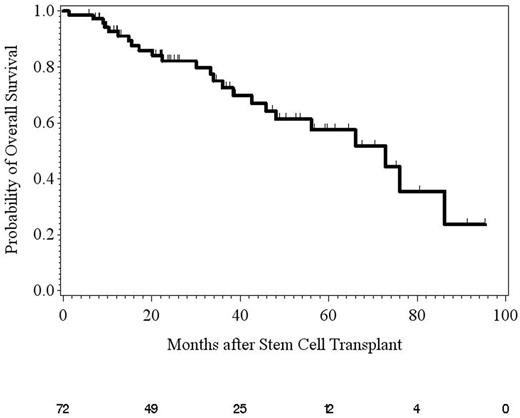Abstract

Introduction
Multiple myeloma (MM) is a disease of elderly with median age of diagnosis 66-years. Autologous hematopoietic stem cell transplantation (auto-HCT) is recommended for eligible patients with newly diagnosed MM, however, it is not offered to many elderly patients due to concerns of excessive toxicity. We have previously reported that auto-HCT can be safely performed in myeloma patients aged ≥ 70 years (Bashir et al. L&L 2012). Here we report the results of a retrospective analysis of MM patients aged ≥ 75 years who underwent auto-HCT at our center.
Methods
All myeloma patients aged ≥ 75 years who underwent auto-HCT at our institution between 1/1/2000 and 12/31/2015 were retrospectively analyzed. Frequencies of toxicities were compared using Fisher's exact test. The cumulative incidence (CI) of non-relapse mortality (NRM) was assessed using the competing risks method. The Kaplan-Meier method was used to estimate overall survival (OS) and progression-free survival (PFS). Differences in survival between groups were assessed using the log-rank test. The association between survival and patient subgroups of interest was determined using univariate and multivariable Cox proportional hazards regression models.
Results
72 patients (median age 76 years; 58% male) were included in the study. Thirty percent (n=19/63) were ISS stage I, 43% (n=27/63) were stage II and 27% (n=17/63) stage III. Seventy-eight percent (n=56) were considered standard-risk (IMWG criteria) and 22% (n=16) had high-risk cytogenetics. Sixty-three percent (n=45) received conditioning with melphalan (MEL) 140 mg/m2, while 38% (n=27) received MEL >140. Seventy-five percent (n=54) of the patients received auto-HCT as part of first line therapy and 85% (n=61) had at least partial response (PR) at auto-HCT. Median time from diagnosis to auto-HCT was 7.6 months. Half of the patients (n=36) received post transplant maintenance. Median follow-up time for all survivors (n=48) was 25.5 months. Grade II-IV toxicity was seen in 74% (n=53) of patients, gastrointestinal being most common (49% of all patients). There was no difference in toxicity between MEL 140 vs. MEL >140. The median time to neutrophil and platelet engraftment was 11 and 12 days, respectively. The CI of NRM was 1% at Day 100 and 6 months and 4% at the end of the assessment period. Day 100 response rate (at least PR) was 92% (n=66), with 36% (n=26) achieving near complete remission (nCR) or better. Median PFS was 31.4 months (95% CI: 22.6, 36.6, Figure 1). Seventy-five percent of the patients were event free at one year after transplant and 23% were event free at 5 years. Median OS was 72.8 months (95% CI: 45.7, 86.2, Figure 2). The OS rates at 1 year and 5 years post transplant were 93% and 58%, respectively. On multivariable analysis, high-risk cytogenetics and ISS stage III disease were associated with significantly worse PFS and OS.
Conclusion
Auto-HCT in myeloma patients aged ≥ 75 years is feasible with response rate and survival comparable to that seen in younger patients. Age alone should not be used to determine eligibility for auto-HCT.
Ciurea:Cyto-Sen Therapeutics: Equity Ownership; Spectrum Pharmaceuticals: Other: Advisory Board.
Author notes
Asterisk with author names denotes non-ASH members.

This icon denotes a clinically relevant abstract



This feature is available to Subscribers Only
Sign In or Create an Account Close Modal